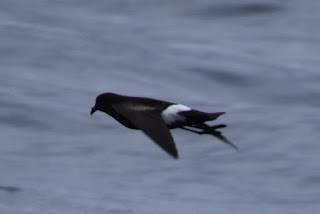Hatteras, NC: Sea Watch and Gulf Stream Pelagic - White-tailed Tropicbird (5/21 - 5/22)
This past weekend I travelled to Hatteras, North Carolina with some birding friends for two days of pelagic birding on the Stormy Petrel II. Unfortunately, weather conditions along the Outer Banks on Saturday made the seas too rough for a boat load of birders to be standing at the vessel’s rails with binoculars and cameras in their hands. So, with an open day at the Cape Hatteras National Seashore, we set out for impromptu birding.
Since we were already near the Cape Hatteras Lighthouse and the winds were mostly out of the east, we decided to spend the morning birding the ocean side. The early part of the morning featured on and off rain that was heavy at times. We birded the flooded lots of the lighthouse campgrounds by car until the rains tapered off around mid-morning. We finally were able to walk out to the beach area and very quickly spotted a late Iceland Gull sitting on the beach. After scanning the nearby roosting Black Skimmers and terns (mostly least terns and royal terns), we moved around to where the land juts out further east than other points along the coast. Here we spent a couple hours scanning the ocean with binoculars and scopes to see what the passing storm system had pushed towards shore. This was safer than being on the boat had it sailed and turned out to be very rewarding.
It wasn’t long before we started to see Wilson’s Storm-petrels and shearwaters, both Cory’s and Sooty. Along the beach, many other expected birds went about their lives, such as Willets, Ruddy Turnstones, American Oystercatchers, Least and Royal Terns. A Roseate Tern was spotted with the other terns resting on the beach. A flock of Red Knots flew in off the ocean and a few Red-necked Phalaropes flew past.
Wilson's Storm-petrel. © S. Weiss
Notice the long legs extending past the tail. The legs of Band-rumped and Leach's Storm-petrels are shorter and do not protrude beyond the tail.
Things really got interesting when a storm-petrel came in very close to shore. This caught the eyes of my friends Jason and Chris, both much more experienced birders than I. Its flight style, longer wings, notched tail and shorter legs made this a Leach’s Storm-petrel, rare to see from land. Shortly after and not too far out, a jaeger seemed to pop up out of nowhere. It was a Pomarine Jaeger. Everyone around was able to get eyes on it before it was lost in the sea swells. But the real highlight of the day was when Jack, another pelagic birder making the most out of his free day, yelled out “Tropicbird!!” Out over the horizon, a White-tailed Tropicbird was gliding southward into the wind.
Left, White-tailed Tropicbird from 2021 Hatteras pelagic. Right, nesting White-tailed Tropicbird in Bermuda, 2016. © S. Weiss
A large, white seabird with elegant long tail streamers is unmistakable, and beautiful, when seen. When scanning the ocean for seabirds, they can easily go unnoticed. They usually soar high in the sky and appear to drop in out of nowhere. They are highly pelagic and rarely seen from land. My only land encounter with them was on a family trip to Bermuda where there was a group nesting on the side of a cliff. As Chris said, “Who needs a boat?!”
By Sunday morning, the sea conditions improved enough that we were able to sail. Unfortunately, the winds had switched over and became westerly, likely pushing most of the birds farther out over the ocean. However, the Black-capped Petrels did not disappoint. We came upon about half a dozen sitting on the water early on, which was a little unusual. But as the winds and swells again picked up during the day, the petrels were off the water, gliding and arcing over the waves. At times we had over a dozen sailing around the boat. Wilson’s Storm-petrels, Cory’s, Audubon's and Sooty Shearwaters provided good viewing opportunities. A few times a Band-rumped Storm-petrel appeared in the chum slick with the more common Wilson’s. A couple of times, it separated from the very similar-looking Wilson’s and soared close to the boat to give great views.
Left, Black-capped Petrel. Right, Audbon's Shearwater (top) with a Wilson's Storm-petrel (bottom). © S. Weiss
Left, Sooty Shearwater. Right, Band-rumped Storm-petrel. © S. Weiss
Notice the Band-rumped Storm-petrel's legs not protruding beyond its scalloped-like tail, and its longer wings compared to the Wilson's Storm-petrel above.
For a few brief moments during the day, a Cape May Warbler fluttered around the boat. The weary migrant, far from land, tried several times to safely land on the boat for a much-needed rest. After a few minutes, it was gone. It’s a long migration for many birds, and some never make it to their destinations. Most birders forget this as they scramble to migrant hotspots every spring, looking to fill their checklists with new year birds. Hopefully this guy made it.
********
Sargassum Crab camouflaged in the floating Sargassum seaweed. © S. Weiss











Comments
Post a Comment